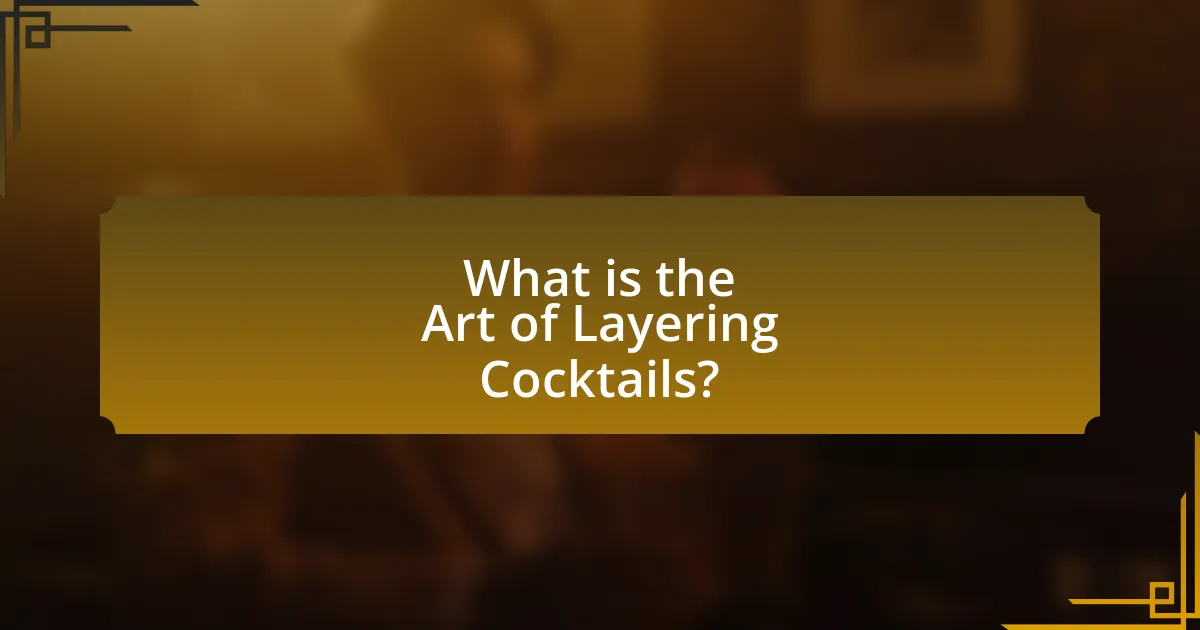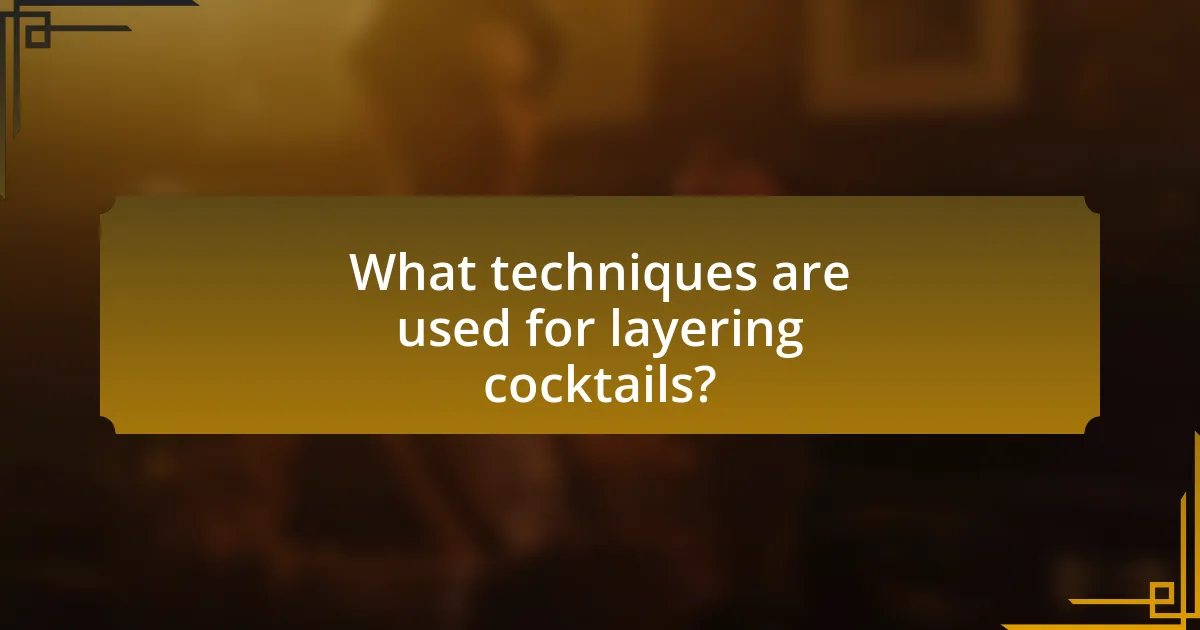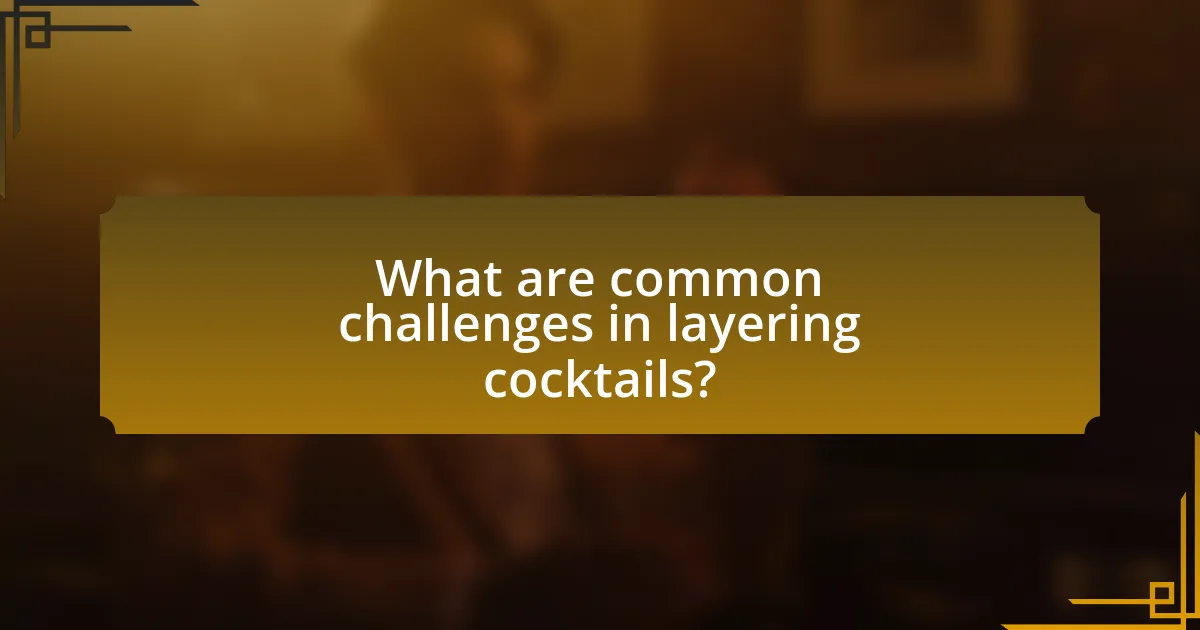The article focuses on the art of layering cocktails, a technique that creates visually appealing drinks by carefully pouring liquids of different densities to maintain distinct layers. It explores the principles behind successful layering, including the importance of ingredient density, precise pouring techniques, and the use of tools like bar spoons. Additionally, the article discusses how visual appeal enhances customer experience and the role of creativity in cocktail presentation. Common challenges and mistakes in layering are also addressed, along with tips for bartenders to refine their skills and achieve stunning layered cocktails.

What is the Art of Layering Cocktails?
The art of layering cocktails involves creating visually appealing drinks by carefully pouring liquids of different densities into a glass so that they remain separate. This technique relies on the principle that liquids with lower density will float on top of those with higher density, allowing for distinct layers. For example, a common layering technique uses grenadine, which is denser than orange juice, resulting in a visually striking gradient effect. Mastery of this art requires precision in pouring and an understanding of the specific gravity of various ingredients to achieve the desired aesthetic without mixing the layers.
How does layering enhance the visual appeal of cocktails?
Layering enhances the visual appeal of cocktails by creating distinct, colorful strata that attract attention and stimulate interest. This technique relies on the varying densities and colors of different liquid ingredients, allowing them to remain separate and form visually striking layers. For example, cocktails like the “B52” showcase this effect, where coffee liqueur, Irish cream, and orange liqueur are carefully poured to create a three-layered drink. The aesthetic impact of such presentations can elevate the overall drinking experience, making the cocktail not just a beverage but also a visual centerpiece.
What are the key principles behind creating layered cocktails?
The key principles behind creating layered cocktails include understanding the density of liquids, using a spoon to control flow, and selecting appropriate ingredients. Liquids with different sugar contents or alcohol levels will have varying densities, allowing for distinct layers when poured correctly. Bartenders typically use a bar spoon to gently pour the lighter liquid over the back of the spoon, minimizing disturbance to the layers below. Additionally, choosing ingredients that complement each other in flavor while maintaining visual contrast enhances the overall presentation. These principles ensure that the cocktail not only looks appealing but also maintains its intended taste profile.
How does the choice of ingredients affect layering?
The choice of ingredients significantly affects layering in cocktails by determining their density and viscosity. Ingredients with different densities will settle in distinct layers when poured carefully, allowing for visually appealing separation. For example, a cocktail made with grenadine, which is denser than most spirits, will sink to the bottom when layered correctly, creating a vibrant gradient effect. This principle is supported by the fact that liquids with higher sugar content, like syrups, are denser than those with lower sugar content, such as juices or spirits, thus influencing how they interact when layered.
Why is presentation important in cocktail making?
Presentation is important in cocktail making because it enhances the overall drinking experience and influences customer perception. A visually appealing cocktail can attract attention, stimulate interest, and create anticipation, which can lead to increased sales. Studies show that consumers often associate the quality of a drink with its appearance; for instance, a survey by the National Restaurant Association found that 67% of diners consider presentation a key factor in their dining experience. Therefore, effective presentation techniques, such as layering, not only showcase the bartender’s skill but also elevate the cocktail’s perceived value and enjoyment.
How does visual appeal influence customer experience?
Visual appeal significantly influences customer experience by enhancing engagement and satisfaction. When customers encounter visually appealing products, such as layered cocktails, they are more likely to perceive them as high-quality and worth trying. Research indicates that 93% of consumers prioritize visual appearance over other factors when making purchasing decisions, highlighting the importance of aesthetics in attracting and retaining customers. Additionally, visually striking presentations can evoke positive emotions, leading to increased enjoyment and a greater likelihood of repeat business.
What role does creativity play in cocktail presentation?
Creativity plays a crucial role in cocktail presentation by enhancing visual appeal and engaging the senses. Innovative designs and unique garnishes can transform a simple drink into an artistic expression, making it more enticing to consumers. For instance, the use of vibrant colors, intricate layering techniques, and imaginative glassware can elevate the overall experience, leading to increased customer satisfaction and potentially higher sales. Research indicates that visually appealing food and drinks can significantly influence consumer choices, as demonstrated in studies published in the Journal of Sensory Studies, which show that aesthetics can enhance perceived taste and enjoyment.

What techniques are used for layering cocktails?
The primary technique used for layering cocktails is the careful pouring of liquids with different densities. Bartenders achieve this by using a bar spoon or a similar tool to gently pour each layer over the back of the spoon, allowing the liquid to flow slowly and settle on top of the previous layer without mixing. This method relies on the principle that denser liquids, such as grenadine, will sink below lighter liquids, like vodka or tonic water, creating distinct layers. The effectiveness of this technique is supported by the fact that the specific gravity of each ingredient determines its position in the layered drink, allowing for visually appealing presentations.
How can bartenders achieve perfect layers?
Bartenders can achieve perfect layers by carefully controlling the density of each liquid used in the cocktail. This involves selecting ingredients with varying sugar content and specific gravity, allowing lighter liquids to float on top of denser ones. For instance, using a syrup or juice with a higher sugar concentration will create a denser layer that sits below a lighter liquid like soda or a spirit.
To pour the liquids without disturbing the layers, bartenders can use a bar spoon or pour over the back of the spoon, which helps to disperse the liquid gently. This technique minimizes turbulence and allows for distinct separation between layers. The successful execution of these methods is supported by the principle of liquid density, where liquids with lower density will float on those with higher density, as demonstrated in various cocktail layering guides and bartending resources.
What pouring techniques are essential for successful layering?
Successful layering in cocktails requires precise pouring techniques, primarily using the back of a spoon and controlling the pour rate. The back of a spoon allows the liquid to flow gently onto the surface of the previous layer, minimizing disturbance and preventing mixing. Additionally, pouring slowly and at a low angle helps maintain the integrity of each layer, as it reduces the force of the liquid hitting the surface. These techniques are essential for achieving visually appealing layers, as demonstrated in classic layered cocktails like the B-52, where distinct color separation is crucial for presentation.
How does the use of tools enhance layering techniques?
The use of tools enhances layering techniques by providing precision and control in the pouring process. Tools such as jiggers, pour spouts, and layering spoons allow bartenders to measure and pour liquids accurately, ensuring that each layer maintains its distinct density and color. For instance, using a layering spoon helps to create a barrier that prevents the liquids from mixing, which is crucial for achieving visually appealing layers in cocktails. This precision is supported by the fact that cocktails with well-defined layers not only look more attractive but also enhance the drinking experience by allowing the consumer to enjoy the distinct flavors of each layer sequentially.
What types of cocktails are best suited for layering?
Cocktails that are best suited for layering typically include those with distinct densities, such as those made with liqueurs, juices, and spirits that have varying sugar content and alcohol levels. For example, cocktails like the B-52, which layers coffee liqueur, Irish cream, and orange liqueur, demonstrate effective layering due to the differences in density among the ingredients. Additionally, cocktails like the Rainbow Shot, which uses grenadine, orange juice, and blue curaçao, also showcase successful layering techniques. The ability to layer cocktails relies on the principle that denser liquids will sink below lighter ones, allowing for visually appealing presentations.
Which ingredients work well for creating distinct layers?
Ingredients that work well for creating distinct layers in cocktails include liquids with varying densities, such as grenadine, orange juice, and blue curaçao. These ingredients can be layered effectively due to their differing sugar content and specific gravity, which allows them to remain separate when poured carefully. For instance, grenadine is denser than orange juice, enabling it to settle at the bottom when layered. Additionally, using a spoon to gently pour the lighter liquid over the back of the spoon helps maintain the separation of layers, enhancing the visual appeal of the cocktail.
How do different spirits and mixers affect layering?
Different spirits and mixers affect layering by their density and sugar content, which determines how they interact when poured into a glass. Spirits with lower density, such as vodka, tend to mix easily and disrupt layers, while denser spirits like grenadine or cream float on top of lighter liquids due to their higher sugar content. For example, when layering a cocktail, pouring a denser liquid slowly over the back of a spoon allows it to rest on top of a lighter liquid, creating distinct layers. This technique relies on the specific gravity of each ingredient, as demonstrated in cocktail recipes where precise layering is essential for visual appeal.

What are common challenges in layering cocktails?
Common challenges in layering cocktails include achieving the correct density of liquids, preventing mixing, and ensuring precise pouring techniques. The density of each layer must be different to maintain separation; for example, denser liquids like grenadine should be poured first, followed by lighter liquids like orange juice. Additionally, improper pouring techniques, such as pouring too quickly or without a barrier, can cause the layers to mix, ruining the visual effect. Mastering these techniques is essential for creating visually stunning layered cocktails.
What mistakes should be avoided when layering cocktails?
To successfully layer cocktails, avoid using ingredients with similar densities, as this can cause them to mix rather than layer. Each layer should consist of liquids with distinct densities; for example, lighter liquids like fruit juices should be poured over heavier liquids like cream or syrup. Additionally, pouring too quickly or without a layering tool, such as a spoon, can disrupt the layering process, leading to a muddled appearance. Lastly, neglecting to chill the ingredients can result in unwanted mixing due to temperature differences, which can compromise the visual appeal of the layered cocktail.
How can temperature differences impact layering success?
Temperature differences significantly impact layering success in cocktails by influencing the density of the liquids used. When liquids are poured at different temperatures, the denser, colder liquids will settle at the bottom, while lighter, warmer liquids will float on top, creating distinct layers. For example, a cold syrup poured over a warm spirit will remain separate due to the difference in temperature and density, allowing for visually appealing layers. This principle is supported by the fact that liquids with lower temperatures are generally denser than those at higher temperatures, which is a fundamental concept in fluid dynamics.
What are the effects of ingredient density on layering?
Ingredient density significantly affects layering in cocktails by determining how well different liquids separate based on their specific gravities. Liquids with lower density will float on top of those with higher density, creating distinct layers. For example, a common layering technique involves using grenadine, which is denser than most spirits, allowing it to settle at the bottom while lighter ingredients like orange juice or vodka remain above. This principle is supported by the fact that the specific gravity of grenadine is approximately 1.2, while that of vodka is around 0.95, illustrating how density differences facilitate visual separation in layered drinks.
How can bartenders troubleshoot layering issues?
Bartenders can troubleshoot layering issues by adjusting the density of the liquids used in cocktails. To achieve successful layering, bartenders should ensure that the ingredients have different specific gravities; for instance, lighter liquids like fruit juices should be layered above heavier liquids like cream or syrup. Additionally, bartenders can pour liquids over the back of a spoon to minimize disturbance and maintain separation. This technique is supported by the principle that liquids with lower density will float on top of those with higher density, allowing for visually appealing layers.
What adjustments can be made to improve layer separation?
To improve layer separation in cocktails, use ingredients with varying densities and pour them slowly over the back of a spoon. This technique allows lighter liquids to float on top of heavier ones, creating distinct layers. For example, using grenadine, which is denser than orange juice, results in a clear separation when poured correctly. Additionally, chilling the ingredients can enhance the separation effect, as colder liquids tend to be denser.
How can bartenders practice and refine their layering skills?
Bartenders can practice and refine their layering skills by using a spoon to gently pour liquids over the back of it, allowing for controlled layering based on density differences. This technique requires bartenders to understand the specific gravity of various ingredients, as denser liquids will naturally settle at the bottom while lighter ones float on top. For example, using grenadine, which is denser than most spirits, can create a striking visual effect when layered correctly. Additionally, bartenders can enhance their skills by experimenting with different combinations of ingredients and practicing with various pouring techniques to achieve the desired visual effects in cocktails.
What are some tips for creating stunning layered cocktails?
To create stunning layered cocktails, use ingredients with different densities to achieve distinct layers. For example, lighter liquids like fruit juices should be poured over heavier liquids such as cream or syrup. Pouring slowly over the back of a spoon helps maintain separation between layers. Additionally, using a jigger for precise measurements ensures that each layer is consistent in volume, which is crucial for visual appeal. The technique of layering relies on the principle that liquids with lower specific gravity will float on top of those with higher specific gravity, allowing for a visually striking presentation.
